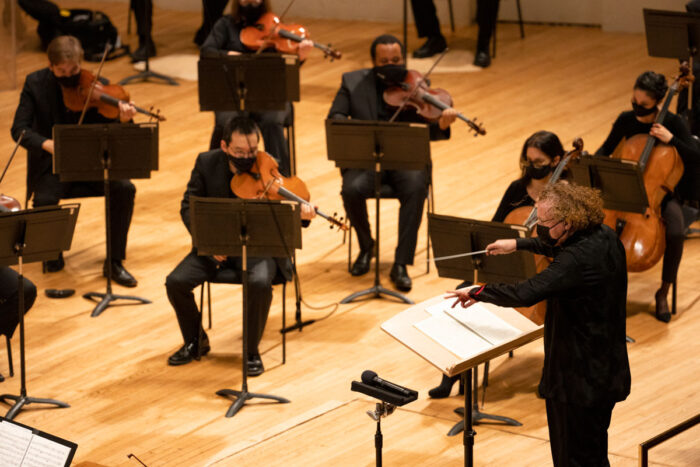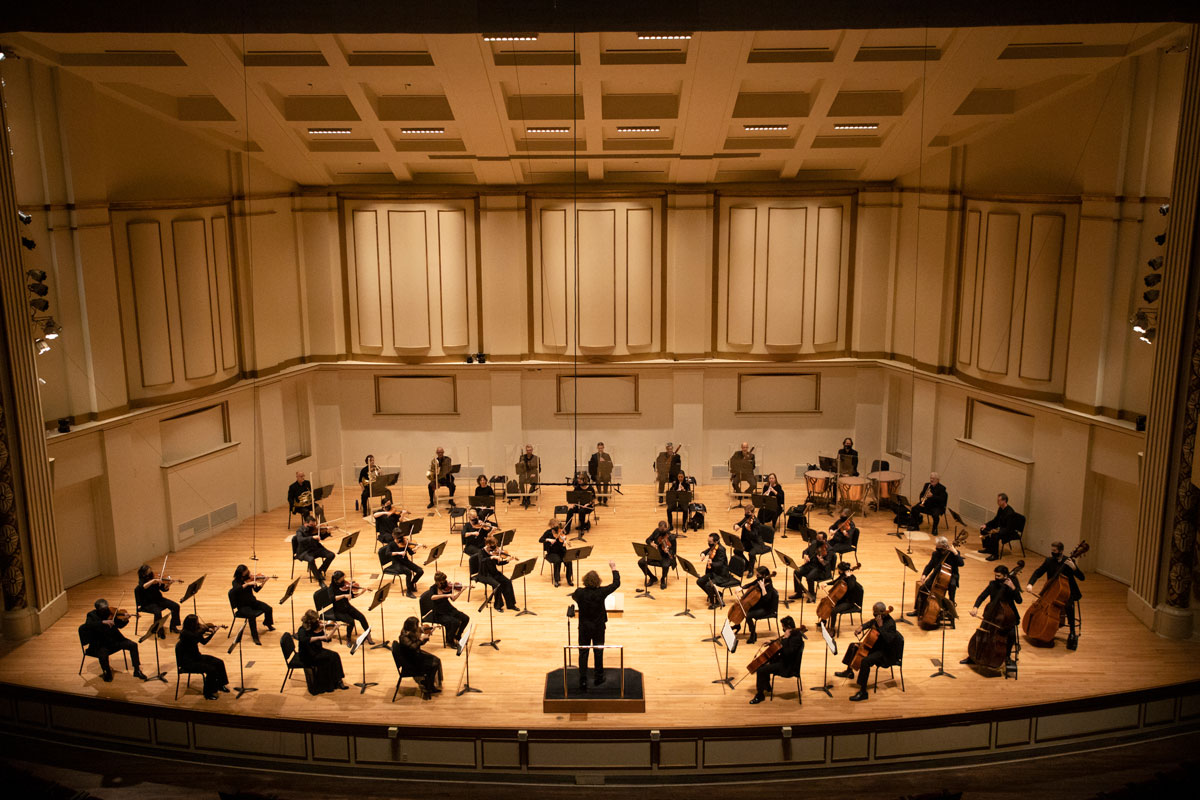Bringing joy to the community safely
Infectious diseases experts help performing arts institutions navigate pandemic
 Dilip Vishwanat
Dilip Vishwanat Infectious diseases doctors and engineers from Washington University in St. Louis have worked with the St. Louis Symphony Orchestra (SLSO) and other cultural institutions on how to safely reopen and continue performances following the COVID-19 pandemic global shutdown in 2020. Stephen Y. Liang, MD, an associate professor of medicine, continues to advise the SLSO on protocols designed to prevent the virus' spread. Pictured is SLSO Music Director Stéphane Denève leading Beethoven’s Third Symphony in October 2020, the symphony's first live performance during the pandemic.
Every now and then, the sonic gusts of Beethoven’s Symphony No. 3 in E-flat major rumble a small office on the 15th floor of the Northwest Tower at Washington University School of Medicine in St. Louis. A blustering, breathtaking, lyrical tour through emotional extremes, the epic composition has inspired Stephen Y. Liang, MD, to persevere through the hardships of the pandemic.
Every time he listens to the Third Symphony, Liang recalls attending the St. Louis Symphony Orchestra’s live rendition in October 2020 at Powell Hall. It was a performance he helped make possible as an associate professor of medicine in the university’s Division of Infectious Diseases. Liang, along with other physicians and scientists at the School of Medicine and engineers from the university’s McKelvey School of Engineering, advised the St. Louis Symphony Orchestra (SLSO) on how to safely reopen after the COVID-19 global lockdown.
Selected for the SLSO’s first performance with a live audience in seven months was Symphony No. 3, titled “Eroica,” which — fittingly — translates to “heroic” in Italian.
“The music reflected humanity’s resilience and courage during an uncertain, devastating time,” said Liang, also an associate professor of emergency medicine. “It was so inspiring and heartwarming to see the joy with which all the musicians and Music Director Stéphane Denève returned to Powell Hall. Whenever I need inspiration and renewed hope at work, I play this one and remember.”
Liang’s role has persisted long after the initial shutdown and following the appearance of the delta and omicron variants. He continues to advise as federal masking and safety guidelines evolve, as vaccines and boosters become available, and as new variants emerge, including BA.2, a subvariant of omicron, and another variant unofficially dubbed deltacron because of its hybrid characteristics.
He also leads Washington University’s efforts in advising other cultural institutions, such as The Muny, The Repertory Theatre of St. Louis, Opera Theatre of Saint Louis, as well as the university’s Performing Arts Department, which staged a well-received run of “Rent” in March.
Working with the institutions has provided numerous and much-needed psychological boosts to Liang and other hardworking health-care workers. “We’ve done a lot of outreach, and, across the board, there’s been this very close, thoughtful, transparent and collaborative approach, both with leadership, the performers and front-line employees,” said Liang, who also has a master’s in population health sciences. “They are all eager to bring joy into the community, and they want to do it safely.”
Not long after the pandemic began, SLSO turned to the university’s infectious diseases doctors in hopes of returning to normal as safely as possible, as soon as possible.
“More than ever, we knew we needed to do our part to bring joy into the community,” said Marie-Hélène Bernard, SLSO president and CEO.
The partnership originally was led by Abigail L. Carlson, MD, now at the Centers for Disease Control and Prevention. It has involved Washington University infectious diseases doctors, including Joseph Cherabie, MD, and Gregory Storch, MD, helping establish protocols such as contact tracing, employee mask and vaccination requirements, and other public health measures. The physicians also have addressed safety concerns unique to the performing arts community — for example, SLSO’s concert hall stage does not allow for the previously recommended 6 feet of social distancing between orchestra members. And woodwind and brass musicians obviously can’t play their instruments while masked.
At first, the musicians practiced separated by Plexiglas. However, studies using aerosol sensors deemed the dividers ineffective. “We found that they created concentrated areas where the air didn’t circulate well, which also negatively affected airflow across the stage,” Liang said. “It is more important to have clear airflow to vents that can filter out viral particles.”
The physicians and engineers also analyzed the potential for viral spread among audience members and created instrument-based profiles of those most likely to spread viral particles (trumpets and trombones were most culpable).
“Washington University’s experts made recommendations specific to our performers and performing environment,” said Erik Finley, SLSO vice president and general manager. “Overall, we’ve had low transmission rates among our musicians, staff and patrons. We owe a lot to Dr. Liang and everyone else there.”
Said Liang: “The pandemic is not over, and I see this partnership continuing as it evolves and hopefully beyond as we think about a post-pandemic normal. Working with the SLSO and other St. Louis institutions has been inspirational and an honor. For me, it’s been a bright spot of the pandemic.”
 Dilip Vishwanat
Dilip Vishwanat






